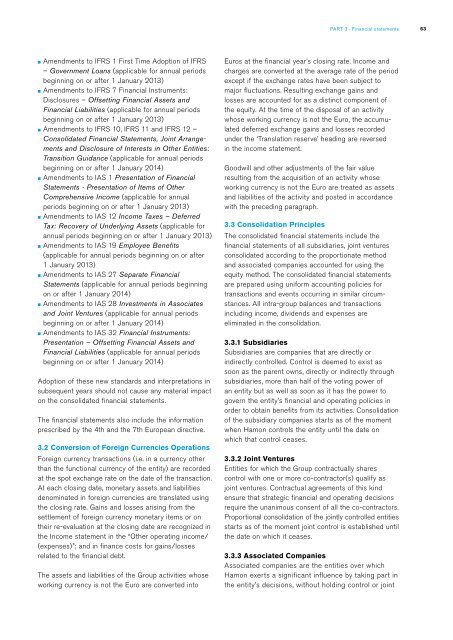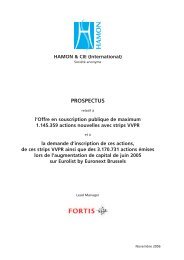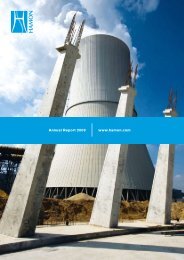Download PDF version English (3237KB) - Hamon
Download PDF version English (3237KB) - Hamon
Download PDF version English (3237KB) - Hamon
Create successful ePaper yourself
Turn your PDF publications into a flip-book with our unique Google optimized e-Paper software.
Part 3 - Financial statements<br />
63<br />
■ Amendments to IFRS 1 First Time Adoption of IFRS<br />
– Government Loans (applicable for annual periods<br />
beginning on or after 1 January 2013)<br />
■ Amendments to IFRS 7 Financial Instruments:<br />
Disclosures – Offsetting Financial Assets and<br />
Financial Liabilities (applicable for annual periods<br />
beginning on or after 1 January 2013)<br />
■ Amendments to IFRS 10, IFRS 11 and IFRS 12 –<br />
Consolidated Financial Statements, Joint Arrangements<br />
and Disclosure of Interests in Other Entities:<br />
Transition Guidance (applicable for annual periods<br />
beginning on or after 1 January 2014)<br />
■ Amendments to IAS 1 Presentation of Financial<br />
Statements - Presentation of Items of Other<br />
Comprehensive Income (applicable for annual<br />
periods beginning on or after 1 January 2013)<br />
■ Amendments to IAS 12 Income Taxes – Deferred<br />
Tax: Recovery of Underlying Assets (applicable for<br />
annual periods beginning on or after 1 January 2013)<br />
■ Amendments to IAS 19 Employee Benefits<br />
(applicable for annual periods beginning on or after<br />
1 January 2013)<br />
■ Amendments to IAS 27 Separate Financial<br />
Statements (applicable for annual periods beginning<br />
on or after 1 January 2014)<br />
■ Amendments to IAS 28 Investments in Associates<br />
and Joint Ventures (applicable for annual periods<br />
beginning on or after 1 January 2014)<br />
■ Amendments to IAS 32 Financial Instruments:<br />
Presentation – Offsetting Financial Assets and<br />
Financial Liabilities (applicable for annual periods<br />
beginning on or after 1 January 2014)<br />
Adoption of these new standards and interpretations in<br />
subsequent years should not cause any material impact<br />
on the consolidated financial statements.<br />
The financial statements also include the information<br />
prescribed by the 4th and the 7th European directive.<br />
3.2 Con<strong>version</strong> of Foreign Currencies Operations<br />
Foreign currency transactions (i.e. in a currency other<br />
than the functional currency of the entity) are recorded<br />
at the spot exchange rate on the date of the transaction.<br />
At each closing date, monetary assets and liabilities<br />
denominated in foreign currencies are translated using<br />
the closing rate. Gains and losses arising from the<br />
settlement of foreign currency monetary items or on<br />
their re-evaluation at the closing date are recognized in<br />
the Income statement in the “Other operating income/<br />
(expenses)”; and in finance costs for gains/losses<br />
related to the financial debt.<br />
The assets and liabilities of the Group activities whose<br />
working currency is not the Euro are converted into<br />
Euros at the financial year’s closing rate. Income and<br />
charges are converted at the average rate of the period<br />
except if the exchange rates have been subject to<br />
major fluctuations. Resulting exchange gains and<br />
losses are accounted for as a distinct component of<br />
the equity. At the time of the disposal of an activity<br />
whose working currency is not the Euro, the accumulated<br />
deferred exchange gains and losses recorded<br />
under the ‘Translation reserve’ heading are reversed<br />
in the income statement.<br />
Goodwill and other adjustments of the fair value<br />
resulting from the acquisition of an activity whose<br />
working currency is not the Euro are treated as assets<br />
and liabilities of the activity and posted in accordance<br />
with the preceding paragraph.<br />
3.3 Consolidation Principles<br />
The consolidated financial statements include the<br />
financial statements of all subsidiaries, joint ventures<br />
consolidated according to the proportionate method<br />
and associated companies accounted for using the<br />
equity method. The consolidated financial statements<br />
are prepared using uniform accounting policies for<br />
transactions and events occurring in similar circumstances.<br />
All intra-group balances and transactions<br />
including income, dividends and expenses are<br />
eliminated in the consolidation.<br />
3.3.1 Subsidiaries<br />
Subsidiaries are companies that are directly or<br />
indirectly controlled. Control is deemed to exist as<br />
soon as the parent owns, directly or indirectly through<br />
subsidiaries, more than half of the voting power of<br />
an entity but as well as soon as it has the power to<br />
govern the entity’s financial and operating policies in<br />
order to obtain benefits from its activities. Consolidation<br />
of the subsidiary companies starts as of the moment<br />
when <strong>Hamon</strong> controls the entity until the date on<br />
which that control ceases.<br />
3.3.2 Joint Ventures<br />
Entities for which the Group contractually shares<br />
control with one or more co-contractor(s) qualify as<br />
joint ventures. Contractual agreements of this kind<br />
ensure that strategic financial and operating decisions<br />
require the unanimous consent of all the co-contractors.<br />
Proportional consolidation of the jointly controlled entities<br />
starts as of the moment joint control is established until<br />
the date on which it ceases.<br />
3.3.3 Associated Companies<br />
Associated companies are the entities over which<br />
<strong>Hamon</strong> exerts a significant influence by taking part in<br />
the entity’s decisions, without holding control or joint














